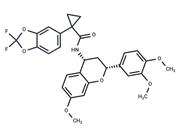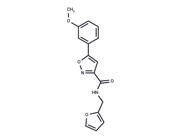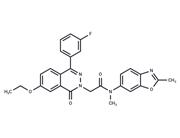| Name | CFTR(inh)-172 |
| Description | CFTR(inh)-172 (CFTR Inhibitor-172) is a voltage-independent, selective CFTR inhibitor. |
| Cell Research | Cell toxicity is assayed by the dihydrorhodamine method at 24 hours after cell incubation with 0–1,000 μM inhibitor. (Only for Reference) |
| Kinase Assay | Screening procedures: Assays are done using a customized screening system consisting of a 3-meter robotic arm, CO2 incubator, plate washer, liquid-handling workstation, bar code reader, delidding station, and two FLUOstar fluorescence platereaders, each equipped with two syringe pumps and HQ500/20X (500 ± 10 nm) excitation and HQ535/30M (535 ± 15 nm) emission filters. The robotic system is integrated using SAMI version 3.3 software modified for two platereaders. Custom software is written in Microsoft VBA (Visual Basic for Applications) to compute base-line–subtracted, normalized fluorescence slopes (giving halide influx rates) from stored data files. The assay is set up by loading the incubator (37°C, 90% humidity, 5% CO2) with 40–60 96-well plates containing the FRT cells, and loading a carousel with 96-well plates containing test compounds and disposable plastic pipette tips. To initiate the assay, each well of a 96-well plate is washed three times in PBS (300 μl/wash), leaving 50 μL PBS. Ten microliters of a CFTR-activating cocktail (5 μM forskolin, 100 μM IBMX, 25 μM apigenin in PBS) is added, and after 5 minutes one test compound (0.5 μL of 1 mM DMSO solution) is added to each well to give 10 μM final concentration. After 10 minutes, 96-well plates are transferred to a platereader for fluorescence assay. Each well is assayed individually for CFTR-mediated I– transport by recording fluorescence continuously (200 ms per point) for 2 seconds (base line) and then for 12 seconds after rapid (<0.5 seconds) addition of 165 μL of isosmolar PBS in which 137 mM Cl– was replaced by I–. |
| In vitro | Administering 20 μg of CFTRinh-172 over 6 hours fully abolished intestinal fluid secretion induced by Vibrio cholerae without affecting the growth of Vibrio cholerae within the body. |
| In vivo | CFTRinh-172, a selective inhibitor of the CFTR (Cystic Fibrosis Transmembrane Conductance Regulator) channel, effectively eliminates Cl- (chloride) currents in the lacrimal gland acinar and duct cells of rabbits. It exhibits time- and dose-dependent inhibition of CFTR-mediated iodide transport and efficiently inhibits the activation of CFTR by various agonists or activators. Notably, CFTRinh-172 induces the production of ROS (Reactive Oxygen Species), mitochondrial depletion, and the activation of the NF-κB (Nuclear Factor kappa-light-chain-enhancer of activated B cells) signaling pathway independently of its CFTR inhibitory action. |
| Storage | Powder: -20°C for 3 years | In solvent: -80°C for 1 year | Shipping with blue ice. |
| Solubility Information | DMSO : 40.9 mg/mL (100 mM)
|
| Keywords | CFTR(inh)-172 | Cystic fibrosis transmembrane conductance regulator | Inhibitor | CFTR(inh) 172 | CFTR(inh)172 | CFTR | inhibit | Autophagy |
| Inhibitors Related | Stavudine | Xylitol | Myricetin | Sodium 4-phenylbutyrate | Hydroxychloroquine | Guanidine hydrochloride | Taurine | Curcumin | Oxyresveratrol | Paeonol | Naringin | Gefitinib |
| Related Compound Libraries | Target-Focused Phenotypic Screening Library | Bioactive Compound Library | Membrane Protein-targeted Compound Library | Autophagy Compound Library | Inhibitor Library | Anti-Fibrosis Compound Library | Bioactive Compounds Library Max | Covalent Inhibitor Library | Ion Channel Targeted Library | Anti-Cancer Compound Library |

 United States
United States



